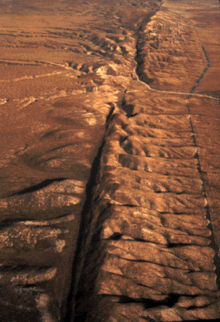Transform fault

A transform fault ( English fault trans form ) is a contact area of two tectonic plates (plate boundary), these two plates slide laterally in the past one another. It is therefore a special case of leaf displacement , in which the two wings of the fault correspond to two different tectonic plates. The transform fault is one of the three types of plate boundaries , along with diverging plate boundaries and converging plate boundaries.
Emergence
Two lithospheric plates slide horizontally past each other along a transform fault . In geology, this process is referred to as conservative or material- neutral, as no earth crust material is formed or destroyed. However, the movement is not frictionless. The plates get caught in one another until the point in time when the pent-up tension becomes too great and suddenly discharges in a shallow earthquake . For this reason, areas near transform faults (like all regions near active plate boundaries) are highly prone to earthquakes.
distribution
Transform faults can along plate boundaries on the mainland , but also on the seabed of the oceans observed. Well-known transform faults are, for example, the California San Andreas Fault and the North Anatolian Fault .
Oceanic plate boundaries
The most common transform faults are oceanic in nature, i.e. found on the sea floor , and divide mid-ocean ridges into segments. They usually cut through the back perpendicular to the direction of the stroke . The disturbances neither form an uninterrupted straight line, nor do they spread at a constant speed . Rather, irregular dislocations occur. Whole sections of the back shift perpendicular to the spreading zone to the left or right and therefore only belong to one another because of the transform disorders.
In the crevices that form, the sea water comes into contact with hotter layers of rock, so that hydrothermal fields with black smokers often arise at the faults .
Continental plate boundaries
Well-known examples can be found on the continents where people are endangered by the resulting earthquakes. The structure of such faults is often more complex there, since the stratification of the rocks is different on both sides of the fault and these rock layers react differently mechanically to the external tension. These complex regions are therefore often called transform zones . The disturbances react to external changes in tension with earthquakes, in which further gaps and crevices can open.
Types
Transform faults go at their ends to other plate boundaries such as mid-ocean ridges (in the typology shortly R for English. Ridge ) or subduction zones over ( deep-sea trenches , short T for English. Trench ). Depending on the types of plate boundaries at the end of transform faults, there are three basic types of transform breaks:
- Back / Back (RR Transform Disorder) - This is the most common type, connecting segments of the mid-ocean ridge
- Ridges / gutters (RT transform disruption)
- Gutters / gutters (TT transform fault)
This typing can be extended in six more specific ways, depending on the direction in which the plate boundaries descend in the channels (subduction zones). or whether they form the top or bottom plate. Depending on the specific combination, the transform disturbances can lengthen, shorten, or stay the same over time.
There are also transform faults that end at a triple point , i.e. at a point where three lithospheric plates meet. The triple points are marked with three letters, depending on the character of the corresponding plate boundaries, next to R and T , F stands for a transform fault .
literature
- Relative movements of two plates on a sphere. In: Eulerpol. TU Freiberg (Scripts - Fundamentals of Geodynamics and Tectonics, PDF; 0.34 MB )
supporting documents
- ^ Claus-Dieter Reuther: Fundamentals of tectonics. Tracking down the forces and tensions of the earth. Springer Spectrum, Berlin / Heidelberg 2012, ISBN 978-3-8274-2065-7 , p. 59 f.

